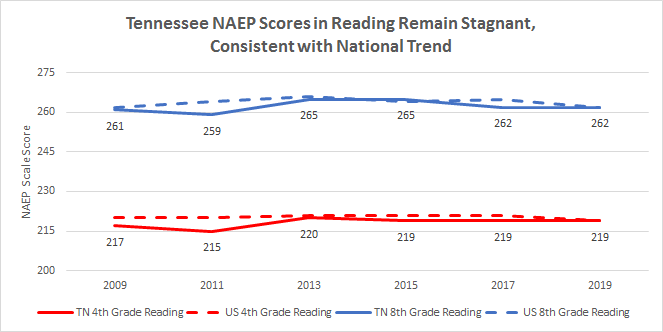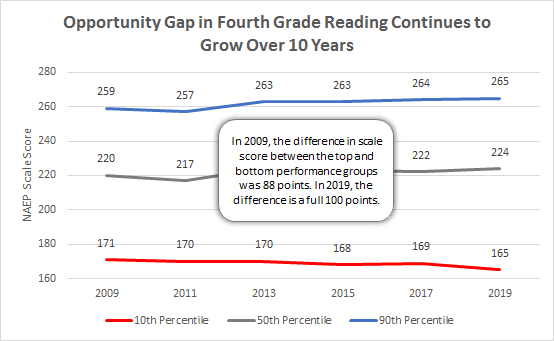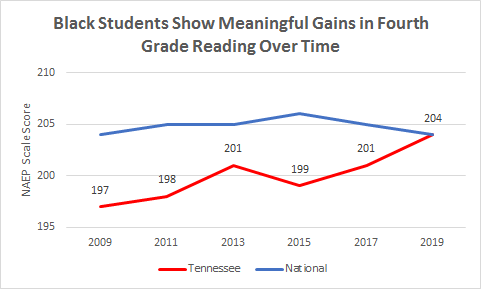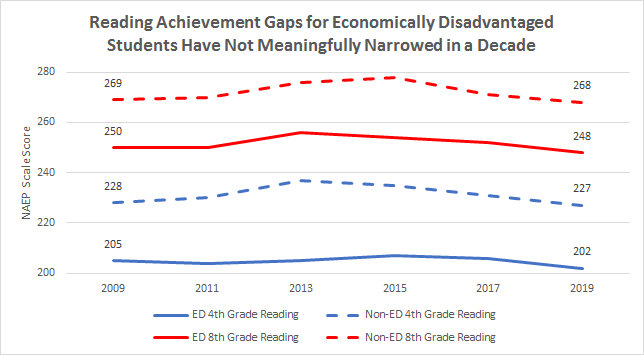
This post is the final in a series focused on exploring Tennessee outcomes on the Nation’s Report Card.
The National Assessment of Educational Progress (NAEP) allows us to track student progress over time and provides a standard measure to compare academic performance between states. Following our analysis of overall results and math outcomes, this post will review student reading performance and highlight emerging trends.
Progress in Tennessee’s reading achievement is consistent with a discouraging national trend. There are concerning patterns across student groups in reading performance. Of particular concern are the expanding learning gaps for economically disadvantaged students as well as the gap between our highest and lowest performing students.
Fourth-Grade Reading Performance Shows Stalled Progress

Similar to the stagnation seen across the country, Tennessee has not seen dramatic performance gains over the last decade. For both fourth- and eighth-grade students, results in 2009 compared to 2019 are not significantly different. This pattern mirrors what we discussed in a blog on this year’s TNReady Grade 3 ELA results as well as research from the Annie E. Casey Foundation that student literacy rates tend to remain stable after third grade while also being very predictive of college, career, and life outcomes.
Gaps Between Highest and Lowest Performance Groups

In one decade, the achievement gap between students in the highest and lowest performance categories has widened by 12 points. This disparity is consistent with a national trend of the highest performing students progressing while students in the lowest performance category show declines over time. This is a clear indicator that we are not doing enough to educate our struggling students or to ensure that all students have a solid foundation in reading when they enter grade four.
Black Students Make Important Gains

As noted in our post on math results, one of the most positive outcomes from this year’s analysis is the progress made by black students in fourth grade. This progress is also reflected in the reading results where black students have made a seven-point gain over the last ten years, reaching an all-time-high scale score on par with the national average.
For Hispanic students in fourth grade, we see a nearly identical pattern to their math achievement. After making large gains in 2015, Tennessee’s results show a steep decline. This drop is in direct contrast to a positive national trend for Hispanic students in fourth-grade reading. The gap between Hispanic students in Tennessee versus the national average has widened by five points over the last decade.
We also see similar achievement in both reading and math for students across geographic locations. Despite their progress over time, fourth-grade students in urban schools still perform below their rural and suburban counterparts. For both rural and suburban students, scale scores do not look significantly different than 10 years ago.
Economically Disadvantaged Students

Across grades, achievement gaps between economically disadvantaged students and their peers look slightly worse than 10 years ago. For eighth-grade students, there is a 20-point; for fourth-grade students the gap is 25 points. Economically disadvantaged students have seen a net decline in performance over the last 10 years. This is further evidence that Tennessee must do more to invest in its historically disadvantaged populations to close opportunity gaps.
Tennessee has seen outsized growth in the past when it raised expectations and supported educators to deliver higher-quality learning opportunities. The stagnant reading achievement over the last three administrations of NAEP are a clear call for improvement for all Tennesseans. Particularly with regard to literacy, Tennessee can work to ensure all students have access to high-quality instructional materials — a particularly timely issue with the upcoming ELA textbook adoption — that emphasize knowledge building across all grades and provide systematic foundational skills building in early grades. The LIFT network provides a model for how Tennessee can ensure the best literacy instruction is made available for all Tennessee students. Tennessee’s future success should be driven, in part, by rising literacy outcomes — not in spite of literacy challenges.
Alexis Parker is a graduate fellow at SCORE. Peter Tang is SCORE’s director of research.
Read more news and analysis on the 2019 NAEP results:
